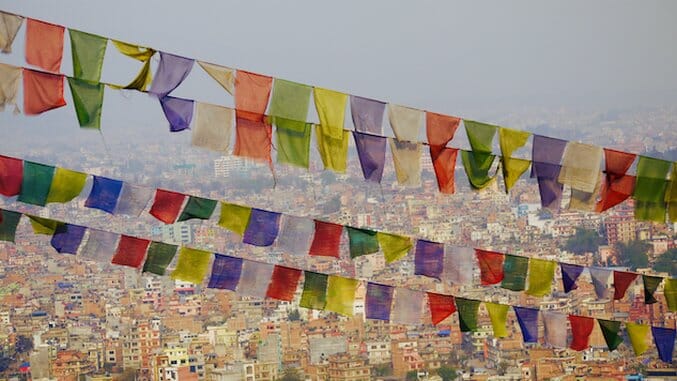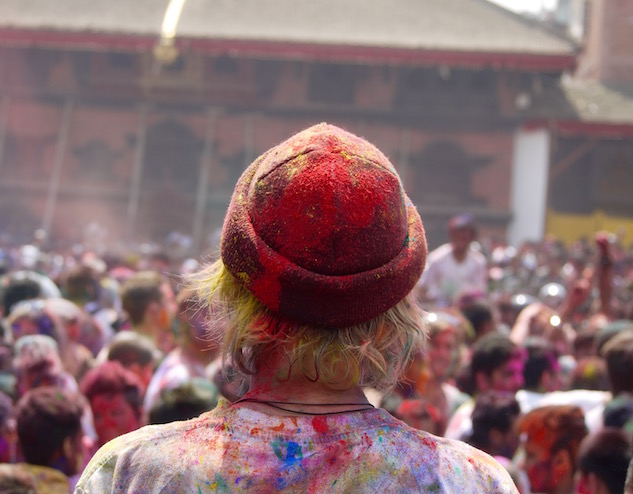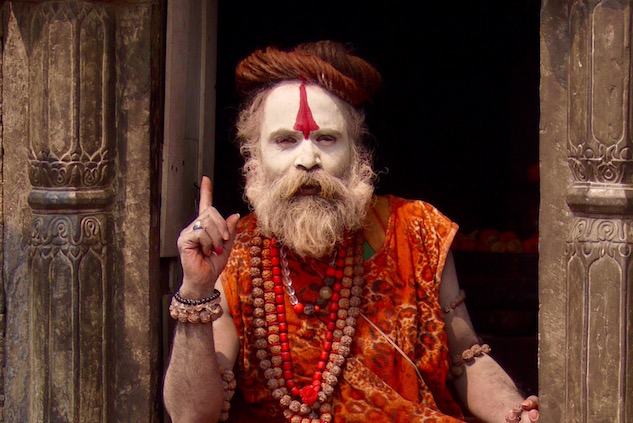
Between The Himalayas and one of the world’s greatest collections of Buddhist stupas and temples, Nepal offers something unique that just can’t be found anywhere else. As the nation’s capital, though, Kathmandu is the hub for Nepal’s momentum into the future and away from its troubled and violent past. Still reeling from the devastating 2015 earthquake, Kathmandu continues to make progress, albeit slower than most would like. It’s dizzying, loud, and one of the haziest places on Earth, but it’s sure to make an impression on anyone who visits.
1. Thamel
When visiting Kathmandu, you’ll more than likely be staying in Thamel, Kathmandu’s tourist and backpacker epicenter. Littered with clothing and souvenir shops, restaurants, cafes, and bars, Thamel is full of vendors who enthusiastically lure you into their establishments. The streets are narrower and more crowded; they are less designed for cars and motorcycles and more for pedestrians and bicycles. Spend an afternoon simply getting lost down alleyways and stumbling upon remnants from the era before contact was made with the west. Thamel might play home to travelers, but it’s still one of the oldest corners of Kathmandu.
2. Swayambhunath Stupa (Monkey Temple)

Located high above Kathmandu’s dusty and congested streets, Swayambhunath, also known simply as the Monkey Temple, is one of the highest landmarks in Kathmandu and offers some of the best views of the city and surrounding valley. Sure, you have to climb a few hundred steps to reach the stupa itself, but in a city that never seems to relent, it might be just the break from the chaos that you need. Damaged in the 2015 earthquake, most of the architecture is still intact and continues to attract tourists and those making the Buddhist pilgrimage en masse. Once you’ve made it to the top, vendors will do their best to attract you to their stalls, offering everything from prayer flags to jewelry to traditional thangka paintings, but it’s the stupa itself that will draw you to the summit.
3. Durbar Square

Many cities surrounding (or now enveloped by) Kathmandu possess their own Durbar Squares, but Kathmandu’s has a history unto itself that still resonates today. Dating back to the 15th century, Durbar Square once housed the Nepali royal palaces before contact with the West had been established. These days though, Durbar Square acts as a site for demonstrations, rallies, and the yearly Hindu Holi festival (pictured), which celebrates the beginning of spring by dousing friends and strangers alike with colorful dyes and water.
4. Patan
One of the Kathmandu Valley’s three ancient cities, Patan has been consumed by Kathmandu as the city itself continues to spread in every direction. Only a three-mile walk from Thamel, Patan seems like another world, calmer and quieter than its neighbor to the north, and the walk there will take you past one of Nepal’s many post-earthquake refugee camps, a haunting reminder of the 2015 disaster that still looms in the dusty air. Patan’s Durbar Square is home to a number of temples in various states of disrepair, but what is left gives you a brief taste of what Patan might’ve looked like during its pre-modernization heyday.
5. Boudhanath Stupa

Recognized as the most important pilgrimage site by followers of Tibetan Buddhism, Boudhanath is one of the world’s largest stupas standing at 118 feet tall. Sadly, Boudhanath suffered severe damage during the 2015 earthquake, however, reconstruction began on the structure in November 2015 and the site is slowly regaining some of its former luster. Monks, nuns, and travelers looking to experience the side of Kathmandu found outside of Thamel’s streets come to Boudhanath for clarity and peace, or to simply bask in the glory of the structure itself. Regardless of your motivation, Boudhanath is the one place in Kathmandu you should not skip.
6. Pashupatinath Hindu Temple

There are two sides to Kathmandu: the Buddhist one that remains at the forefront because of the country’s proximity to Tibet and its role as the birthplace of Siddhartha Gautama Buddha, and then the Hindu side, which makes up more than 81 percent of the country’s population. Most of Kathmandu’s most popular tourist sites are tied to the country’s most famous son, but if you wish to see a truer side of Kathmandu, visiting Pashupatinath, the city’s most important Hindu temple complex, can provide that. Cremation smoke flows up from riverbank funeral pyres located next to the temple complex while a slew of Hindu holy men hawk photo opps for $5 a pop. It’s abrasive, bright, and unforgettable, much like many of Kathmandu’s most hidden corners.
7. Garden of Dreams
Located just outside the chaos of Thamel, the Garden of Dreams is a necessary oasis for any visitor to Kathmandu. Although the Garden of Dreams lacks the spiritual importance found in the endless number of temples and shrines scattered throughout the city, it does offer two things that have become increasingly difficult to find in the busy capital city: clean air and greenery. The Garden of Dreams boasts nearly 75,000 square feet of greenery, pagodas, trees and ponds, an amphitheater, and six pavilions, each of which represents one of Nepal’s six seasons. The Garden of Dreams might not play as big of a part in Kathmandu’s storied history, but that doesn’t mean that you won’t experience some kind of enlightenment once you enter the grounds.
Max Bonem is a writer and eater currently traveling through Southeast Asia. You can follow his travels via his blog, Instagram or Flickr.